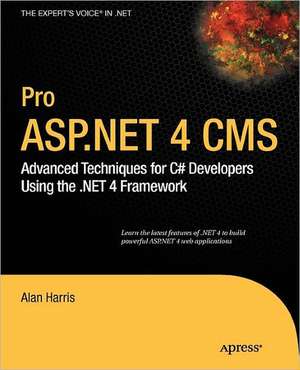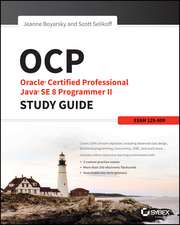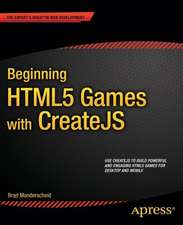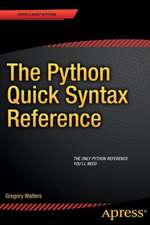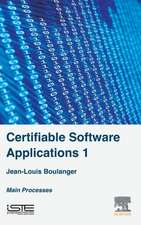Pro ASP.NET 4 CMS: Advanced Techniques for C# Developers Using the .NET 4 Framework
Autor Alan Harrisen Limba Engleză Paperback – 22 iun 2010
This book will immerse you in a variety of advanced topics, including architecting different application data tiers, memory caching paradigms, data mining, and search engine optimization. Working through step-by-step exercises using P/LINQ, DLR, MEF, MVC, IronPython, Axum, and Ajax, you will learn a variety of approaches to building each of the key application tiers common to all web solutions.
Using a proven technique of illustrating advanced concepts with functional solutions, all topics in the book are modeled on a fully operational content management system (CMS), built from the ground up. This ensures that you’ll be introduced to real-world examples that demonstrate the full functionality of the .NET 4 Framework for ASP.NET, and that you’ll be able to apply your new skills to any web development situation.
Preț: 211.51 lei
Preț vechi: 264.39 lei
-20% Nou
Puncte Express: 317
Preț estimativ în valută:
40.49€ • 42.25$ • 33.94£
40.49€ • 42.25$ • 33.94£
Carte disponibilă
Livrare economică 20 februarie-06 martie
Preluare comenzi: 021 569.72.76
Specificații
ISBN-13: 9781430227120
ISBN-10: 1430227125
Pagini: 316
Ilustrații: 320 p.
Dimensiuni: 178 x 254 x 17 mm
Greutate: 0.54 kg
Ediția:1st ed.
Editura: Apress
Colecția Apress
Locul publicării:Berkeley, CA, United States
ISBN-10: 1430227125
Pagini: 316
Ilustrații: 320 p.
Dimensiuni: 178 x 254 x 17 mm
Greutate: 0.54 kg
Ediția:1st ed.
Editura: Apress
Colecția Apress
Locul publicării:Berkeley, CA, United States
Public țintă
Popular/generalCuprins
Chapter 1: Visual Studio 2010 and .NET 4.0, An introduction to the terms, technology and general course of the book and what readers should hope to gain, as well as a broad overview of what's new in both Visual Studio 2010 and .NET 4.0 Chapter 2: N-Tier Architecture and Component-Based Development, An overview of n-tier architecture and how it will be utilized throughout development of the code within this book, and instruction on coding practices such as coding to interfaces and reusable components. Introduces 'Bookshelf', the storefront / review application to be built throughout the book Chapter 3: Data Tier via P/LINQ and the Entity Framework, Describes the creation of the data tier, touching on LINQ, the Entity Framework and the PLINQ extensions that allow for parallel processing of LINQ queries Chapter 4: Business Tier via DLR and MEF, Walks through creating a business tier for the shop. This chapter addresses the Dynamic Language Runtime as well as the Managed Extensibility Framework with the intention of building a business tier that can easily be expanded and modified in the future Chapter 5: Presentation Tier via MVC and AJAX, Explains how to most effectively use the MVC Framework to develop a standards-compliant, lean, fast UI that supports a variety of user-friendly AJAX features. Also explains the Routing changes made in the SP1 release of .NET 3.5 and fully integrated in .NET 4.0 with new convenience methods Chapter 6: Caching Tier via Memcached / Velocity, A functional app is not sufficient on the modern web; a functional and highly available app is the yardstick of development success. This chapter describes how to use a distributed caching system (either Memcached, which is not a Microsoft component, or alternatively I can use MS Velocity) to easethe load on the database and increase overall system responsiveness Chapter 7: VS2010 Black Box Debugging, Shows how to use the new 'black box debugging' features of Visual Studio 2010 to 'rewind' the state of an application and track down bugs in a reproducible fashion. Also explains how and why to use WinDbg when tracing and basic debugging steps fail to produce the desired solution Chapter 8: Data Mining via IronPython and Axum, Explains how to use IronPython and the Axum languages to perform data mining tasks in a highly-scalable, concurrent fashion, enabling the user to extract information from large amounts of system data Chapter 9: Search Engine Optimization, Details how to apply SEO techniques to the Bookshelf application (as well as what techniques we've already applied without explicitly walking through them previously). Also examines how to make use of the new MS SEO Toolkit that can be integrated with IIS7 to improve the way search engines view your site
Notă biografică
Alan Harris is a web and application developer living in Arlington, Virginia. He has worked at more than a few organizations using .NET to create enterprise solutions since the glory days of version 1.1, and can still browse to some of the oldest ones. Aside from working at his desk, he spends most of his time studying Krav Maga and writing music.
Caracteristici
This book will immerse you in a variety of advanced topics, including architecting different application data tiers, memory caching paradigms, data mining, and search engine optimization.
